Leticia and The Amazon – Friday 21st to Friday 28th October 2016
As we arrived at Leticia airport after an hours flight south over the Amazon rainforest there was a commotion. Bogotá’s number one boy band had arrived on the same flight as us to be greeted by a gaggle of women at the gate, and as they were taken away on top of a fire engine followed by hoards of fans on motorbikes and scooters we paid our tourist tax and were met by Antonio from the tour company Amazon Jungle Trips.
Leticia is a small town at the southernmost point of Colombia where it borders Peru and Brazil, and is a port on the river Amazon. It’s a busy, unsophisticated place with one smart hotel and a large number of backpacker’s hostels. Antonio had booked us into one such hostel and after dropping off our luggage we headed out to see the main attraction of Leticia, the parakeets returning at dusk to the central park in Leticia. They were an amazing sight, flocks of birds returning in their thousands to roost in the branches of the tall trees which were laden, the birds making an incredible din with their squawking. After a beer and chicken and rice for supper in a restaurant on the street watching the traffic go by and part of the film Troy dubbed into Spanish, we didn’t want to sit in our somewhat dismal hostel so the hostel owner, Phillipo, took us in his tuktuk to try to see the Bogotá boy band who were playing in a stadium on the edge of Leticia. Unfortunately they weren’t on until 1am, a bit late for us, so we sat in a bar and watched couples dancing to Latin beats before heading for bed.
Day 1 of our jungle trip
Leaving most of our luggage at Antonio’s office we had packed everything we would need into two small rucksacks. On the Leticia waterfront we climbed into the wooden boat that would take us out along the Amazon to the jungle lodge where we would be staying along with the six other intrepid travellers who were to be our companions on our jungle adventure. No wifi or mobile phone reception for a week… how would we cope? The houses along the waterfront are built on floats of wooden tree trunks so they would rise or fall depending on the water level in the river, which can vary by 30 to 40 feet in height during the year due to the heavy rainfall in the rainy season. The river was very low and there were houses stranded up on the river bank, with vultures sitting around looking sinister. The Amazon was an uninviting, dingy brown colour. There were lots of little wooden boats with propellers on long prop shafts for manoeuvrability, river steamers which plough their way up and down the river, and the fast speedboats that connect Leticia with Iquitos in Peru, and Manaus in Brazil in a matter of 12 or 36 hours respectively (reportedly not a particularly comfortable trip). At one point we had thought we might take the three or four day river steamer up or down the Amazon. You can hang your hammock on deck and watch the river bank pass by at a slow pace. But then we discovered Amazon Jungle Trips which offered trips into the jungle to see the animal and plant life in the high and low forest, and this sounded much more interesting.
We soon took a tributary off the main river Amazon, up the Rio Javari, with low woodland on one bank and reeds growing on the other with birds wading in the shallows. It was an overcast, chilly day and soon started to rain with the drops stinging our eyes as the boat sped along, despite the canopy over the boat. We passed the settlement of Benjamin Constant, wooden houses on stilts sprawling along the south bank, a church, a dredger, occasional wooden boats, one laden with bananas, one with old refrigerators, small canoes with families in them.
It was a 75km trip to the Zacambu Rainforest Lodge, some 90 minutes until we reached a narrow offshoot from the main river, with dolphins appearing briefly as we turned into the tributary. The lodge was built on stilts on the river bank with a long jetty and stairway leading up, to allow for rising water levels. It had two main communal rooms overlooking the river, one with dining tables, the other with hammocks to relax in. Our bedroom was simply furnished – a small double bed with lurid pink mosquito net and some pictures of birds on the wood panelled walls. We were soon straight off on our first excursion, a short boat trip along the river to a nearby lake, where we saw eagles, cormorants and kingfishers.
Our fellow adventurers were two German artists: Gudrun who produced installations by filming footage of the trees and vegetation which she projected onto large buildings in black and white; and Klaus who was planning to record underwater sounds of the river using a hydrophone that he had designed himself. He was unsure what sounds he would hear. There were also Clare and Katrina from the British Foreign and Commonwealth Office in Bogotá, and Simon and Lukas, two young physiotherapists from Salzburg.
After a lunch of chicken, rice and salad we donned Wellington boots and liberal amounts of mosquito repellent and headed off along tracks through the jungle with our indigenous guide, Rolando. As we walked along the trail, accompanied by a constant swarm of mosquitoes, he pointed out termite nests built high up the tree trunks above the highest water line. He used his machete to cut a slash in a rubber tree to show how the tree would bleed rubber.. up to 3 litres a day, before carefully blocking the wound to stop the tree from bleeding further. Rubber trees are native to the Amazon and rubber had been used by Amerindians for centuries before the ‘rubber boom’ of 1879 to 1920 caused terrible suffering to some of the indigenous population in the Amazon basin who were enslaved to work in rubber production. Rolando coaxed a small tarantula out of its web-like nest in a tree trunk and placed it on the backs of our hands, where it felt so light I could hardly feel it walk on me. It was somehow quite beautiful and it was thrilling to have this creature so close. Further on he pointed up to a dark shape high up in the canopy and climbed up to grab a four toed sloth and bring it down closer to us so that we could see it. It didn’t look very pleased and hurried off as fast as a sloth possibly could as soon as it was released.
We were met by our boat and on the way back we stopped at a sandy beach on the banks of the river, as the sun was getting lower in a dramatic sky, and Simon and Lukas swam in the muddy river.
Meanwhile Rolando was running back and forth across the beach chasing something. He was catching little green lizards as they emerged from their burrows in the sand and tried to run for the safety of the undergrowth and trees, a journey that would normally be hazardous as birds tried to pick them off. They were only three weeks old and he soon had a handful of them.
That night after supper we headed off in the darkness by boat to the river banks and Rolando waded into the water in his wellies and grabbed a small caiman, which he brought back to the boat. It was a ‘chica’, a girl, about three months old and about 18 inches long, very sweet, and we all held it for photographs before Rolando carefully returned it to the river. Further on he found an older caiman, about three foot long, another female, which we passed around. Rolando stroked its pale soft belly and it appeared to respond with pleasure, drawing up its legs.
Day 2
The next morning we had pancakes with maple syrup for breakfast and from the lodge balcony we could see dolphins slowly progressing down the river. Our excursions this day started with a walk through the low forest with Rolando pointing out trees and plants that have medicinal uses and have been used by his ancestors over the centuries. One had a sticky orange sap that he smeared on our hands.. it was a mosquito repellent. Another had poisonous sap. The forest was more like a woodland than the dense jungle that I’d anticipated: a carpet of dead leaves with shoots of new growth forcing their way up; tall, slim, straight young trees reaching for the light. There was evidence that many of the larger trees nearer the river had been felled either for logging or to build the dugout canoes and wooden boats that are used on the river. We saw a colourful parrot with red chest and green back sitting on a branch, brightly coloured butterflies in vivid blues, yellows and oranges, a dragonfly with a red body and transparent wings, a woodpecker with a red head and black and white body, an eagle high up in a tree, a toucan. There were beautiful brown mushrooms and bromeliads living on the branches of the bigger trees. My digital SLR camera with zoom lens chose this moment to succumb to the heat and humidity of the Amazon and packed up.
After lunch we headed off along the river in the boat and motored through the brown water looking up into the trees along the river bank. It was surprising how little there was. We had expected it to be teeming with animals and birds but only occasionally did Rolando point out some bird that he spotted high up in a tree.
There was only electricity at the lodge between 6 and 9pm when the generator was running, so after a shower, supper and a cold beer it was wise to be in bed by 9pm otherwise you’d be getting undressed by torchlight.
Day 3
We were woken the next morning at 4.45am and it was starting to get light by 5am as we headed off to the main river where the boat engine was switched off and we sat in the still morning listening to the sounds of the jungle: cicadas, bird songs and the occasional group of monkey crashing through the trees. After a breakfast of eggs, fruit and strong coffee we headed off again by boat to be dropped off for another walk through the jungle. There were massive buttress trees stretching up high into the canopy, creepers hanging down from tall trees and others spiralling upwards, the skeleton of a dead sloth lying by the path, more jungle medicines, giant lily pads, water holes which enable the 5 meter anacondas to move from lake to lake. We were as usual accompanied by clouds of mosquitoes and despite thinking we’d thoroughly covered ourselves with repellent Hugh’s back and shoulders were pinpricked where they’d bitten through his shirt, and I had red lumps on my eyelids and around my eyes.
In the afternoon we all went off again in the boat to fish for piranhas using fishing line hanging from rods made of branches and bits of chicken and fish threaded onto hooks for bait. We were like little children – splashing the water with the end of the rod which supposedly attracts the fish and so excited when we made our first catches. We caught a variety of 6 to 8 inch fish, some evil-looking silver fish with dangerous spines and the occasional beautiful, red, gleaming piranha with a mouthful of sharp, pointed teeth.
After we’d caught enough fish, and thrown them back, we motored down the river to a beach where we all swam. It was shallow and muddy and slimy underfoot but it had to be done. Back at the lodge I had a shower. A small green frog clung to the window screen.
Day 4
We were woken at 5.30 am by a gentle tapping on the door by Rolando who slowly paddled Hugh and me in a wooden canoe along the laguna at the back of the lodge to look for adult caiman. We could hear the monkeys chattering in the trees, the strange, loud, creeping call of the sigwana bird and bright birdsong, whistles, ringing, echoing sounds, in the otherwise still morning. Rolando made sucking noises to attract the caiman, then deep guttural noises, but it wasn’t until we had turned back towards the lodge that we saw in the distance a large caiman gliding across the middle of the lake, leaving a trail in the flat water, only its head visible before it sank out of sight.
After breakfast we headed off by boat back to Leticia, to drop Lukas and Simon off for their flight back to Bogotá and to take us on to the next lodge in the high jungle. Our guide for this part of the tour was Avelado, who had an impish face which frequently broke into huge grins. From Leticia we headed upriver along the main Amazon. Much of the land along the river banks had been cleared of trees, with small villages and settlements, farms with cattle and some huge and expensive-looking tourist lodges. We arrived after about 70km at the indigenous village of La Libertad on the river banks and watched as a group of young children disembarked from an open wooden boat, presumably at the end of their school day. It was a 45 minute walk through the forest to the next lodge, initially through the village with simple wooden houses on stilts, a few people and dogs hanging around, banana plants, pineapple, yucca being cultivated, lots of birds – macau and other parrots. It was more dense and lush here in the high forest and Avelado clearly enjoyed swinging his machete to clear the path through the jungle.
Our hosts were Walter and Luce and the lodge was in a large clearing with flowering shrubs and tall trees where noisy pitcher birds had built their nests hanging from the branches, the males with long yellow tails, the females a drab brown. By the main house was a murky lagoon where they kept Margarita, the pet caiman, which they fed with bits of fish and would laugh uproariously when it snapped at the scraps.
At supper we noticed a black shape struggling in the netting in the roof which Hugh was initially horrified might be a tarantula. He realised it was a little bat and persuaded Walter to free it, which he did, carefully cutting away the netting in which it was horribly tangled. It had a vicious looking face and sharp teeth. I didn’t point out to Hugh the large tarantula in the roof beams above us.
We were the only guests at the small lodge which had three circular thatched guest rooms in the gardens. The generator came on for a couple of hours after dark so we headed off to bed at 8pm and lay huddled in bed in the pitch black, under our pink mosquito net, listening to the scrabbling, squeaking noises in the rafters above us. Shining my torch up, in its light a small, black mouse peered down at me. We played 20 questions to pass the time and to blot out the terrifying noises from above. I didn’t sleep well that night.
Day 5
We woke early to a beautiful, bright, sunny morning. The pitcher birds were in full voice, squawking louder than ever. Just outside our front door was a large, dark stain of what appeared to be a pool of blood.
Luce served us a huge breakfast of a large piece of muddy river fish in broth with maize, rice, bread, papaya and banana. Luce was a lovely, generous woman and had made this local specialty for us. I struggled to eat as much of the fish as I could but surreptitiously fed some to her little lap dog, Nina, which followed me around after that looking hopeful.
We found boots of the right size from a huge pile of wellingtons, made sure there weren’t any creatures nesting inside them, then headed off with Avelado into the jungle which was much more dense than in the previous low forest. There were huge buttress trees reaching high up towards the sky, ferns and palms trees and it felt more like jungle than woodland. We wound up and down crossing a few streams. Avelado pointed out flying insects, a small brown frog shaped like a leaf, butterflies, and showed us how to get water to drink by cutting through the woody stem of a particular vine.
Back at the lodge Luce served us another huge meal of chicken, pasta, chips made of yucca root, rice, salad, fresh pineapple and papaya. I had been undecided about whether to sleep that night in the jungle in a hammock, which Hugh was keen to do, but I decided that staying by myself in our hut with the noisy mice was the more unpleasant prospect. Avelado seemed surprised we’d decided to go but quickly sorted hammocks, mosquito nets, a huge tarpaulin, blankets, cooking pot, supper and water all into a large bag which he suspended from his forehead by a strap (we did help by carrying what we could manage). We walked for almost 30 minutes into the jungle to where there was a framework made of tree branches tied together from which, having cleared away dead branches from the site, we suspended our hammocks. There was a cacophony of noises, unceasing birdsong, shrill calls and replies, with a constant background of frogs and cicadas, which went on all night long. As it started to get dark there were distant gunshots – hunting jaguar? Avelado and Hugh built a fire whilst I climbed into my hammock under the net to escape the mosquitoes and almost fell asleep, it was so comfortable.
Avelado fetched muddy water from the stream to boil yucca root in his pot and baked the fish he’d brought over the fire. As we were sitting by the fire he spotted the bright eyes of a creature in the bushes and went off to investigate. A jaguar, just a small one, he said. Strangely I didn’t feel at all concerned, I was more worried about getting a parasitic infection from the dirty water in which he’d cooked the yucca, or from the mushy, undercooked fish. I wouldn’t have made a good boy scout. After our meal we went to bed but sleep wouldn’t come for hours, the hammock no longer felt quite so comfortable and it was cold despite the blanket. Twice I had to get up to go to use the nearby clearing in the dark jungle. It was only later that I worried about a jaguar attacking and crushing my skull in its powerful jaws – although I have read that they rarely attack humans.
Day 6
We woke before 6am and despite my being quite cosy by now in my hammock Avelado was keen to pack up camp and get back. After breakfast at the lodge (another feast of omelette, pancakes, fruits, juice and hot chocolate), he showed us some of the indigenous ways, squashing leaves to extract red dye to paint our faces and arms, how to dance for the spirits, to use his father’s two meter blowpipe to hit a target and to make pipes from the stems of reeds.
Luce produced a huge lunch of more fish before we said goodbye to her and trekked back to the river. Avelado introduced us to his mother who lived in the village of La Liberdad. She had a baby monkey clinging to her dress which screamed when she tried to remove it. We were able to see how the indigenous people lived and to buy some souvenirs of bracelets, necklaces and dream catchers that they’d made. The village was clearly very poor, young people were lolling around in hammocks with the TV on (no different from home then), a man was cooking a huge pot of yucca root, preparing for a feast for the whole village. We were shown a big thatched open sided hall where community events took place.
We sat on a bench by the river with Avelado, Walter and some men from the village. They were laughing amongst themselves and repeating the word ‘zombie’. When I asked why they explained that they thought the dog looked like a zombie and this was clearly hilarious. They seem to have such a relaxed attitude to life, hunting and fishing only when they need to eat, chatting, smiling, laughing and finding humour wherever they can.
After an hour the local commercial speedboat arrived and we climbed on board for the ride back to Leticia. Back at the office of Amazon Jungle Trips they seemed shocked when Avelado told them he’d seen a jaguar. Not good for business if their clients get attacked I suppose.
After booking into our hostel we went out for cocktails – Caipirinhas, Brazil’s national cocktail made with cachaça (sugar cane rum), sugar and lime, and lots of ice, delicious – in Leticia’s one smart hotel. The décor was very Amazonian with a giant anaconda suspended from the ceiling.
The next morning we had a breakfast of empanadas and coffee sitting outside a small shop on the street, watching the motorbikes, tuktuks and taxis go by. We just had time to buy souvenirs of gaudily painted parrots and toucans, and balsa wood masks before the taxi arrived to take us to the airport. From the plane we could watch the long expanse of green jungle below with the winding river snaking through it, as we headed back north to Bogotá.

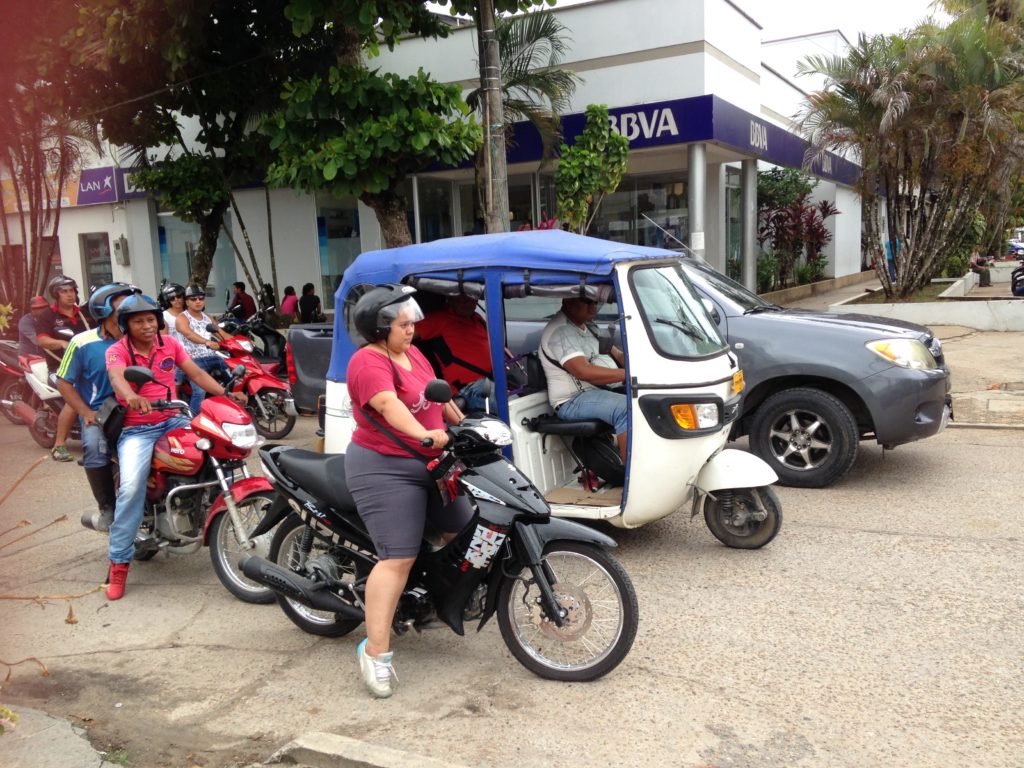
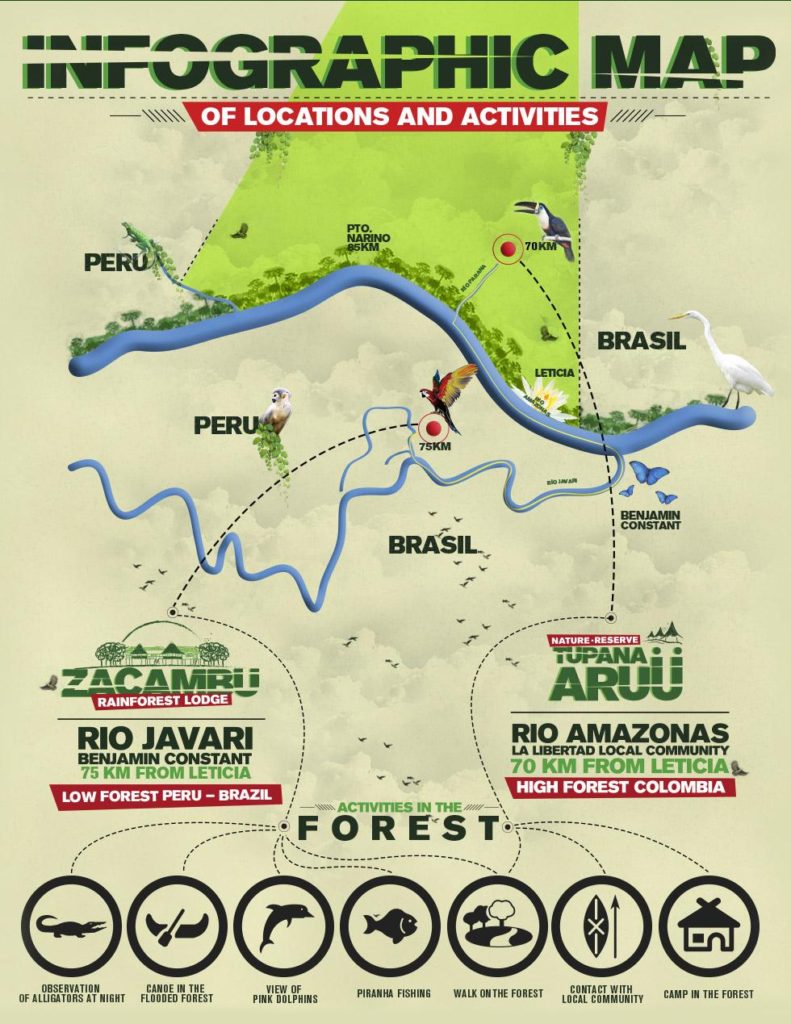
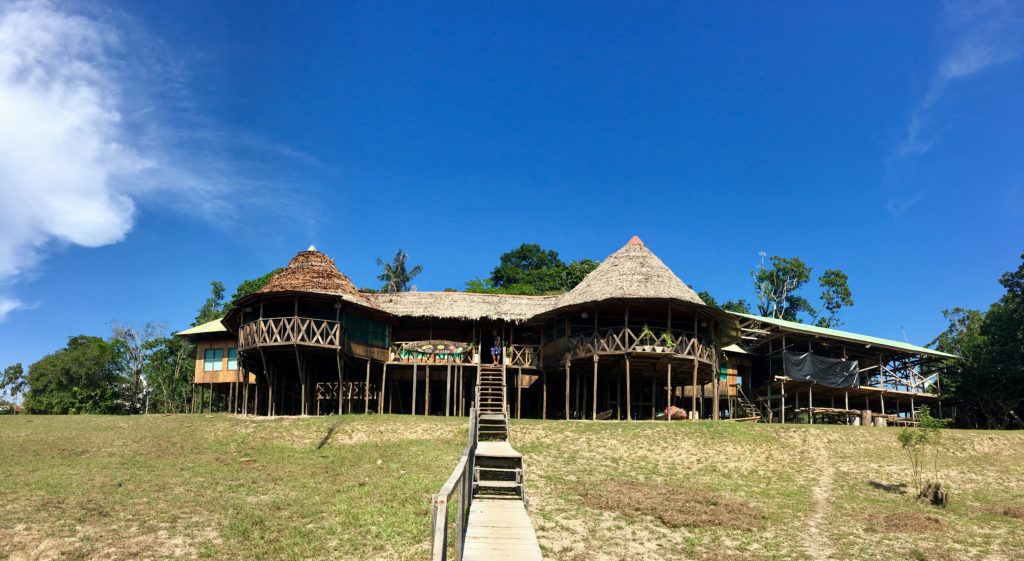







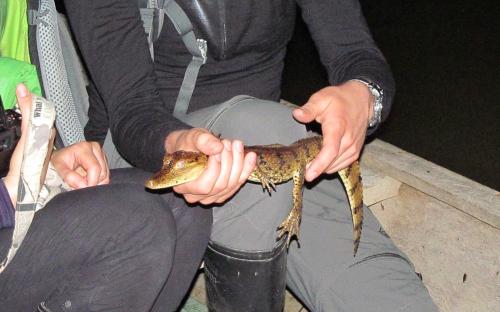
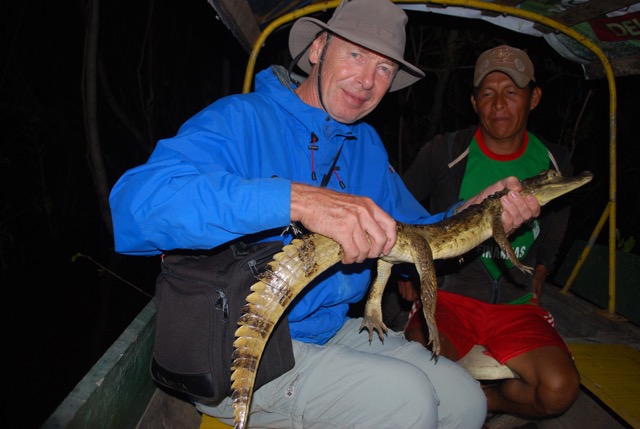


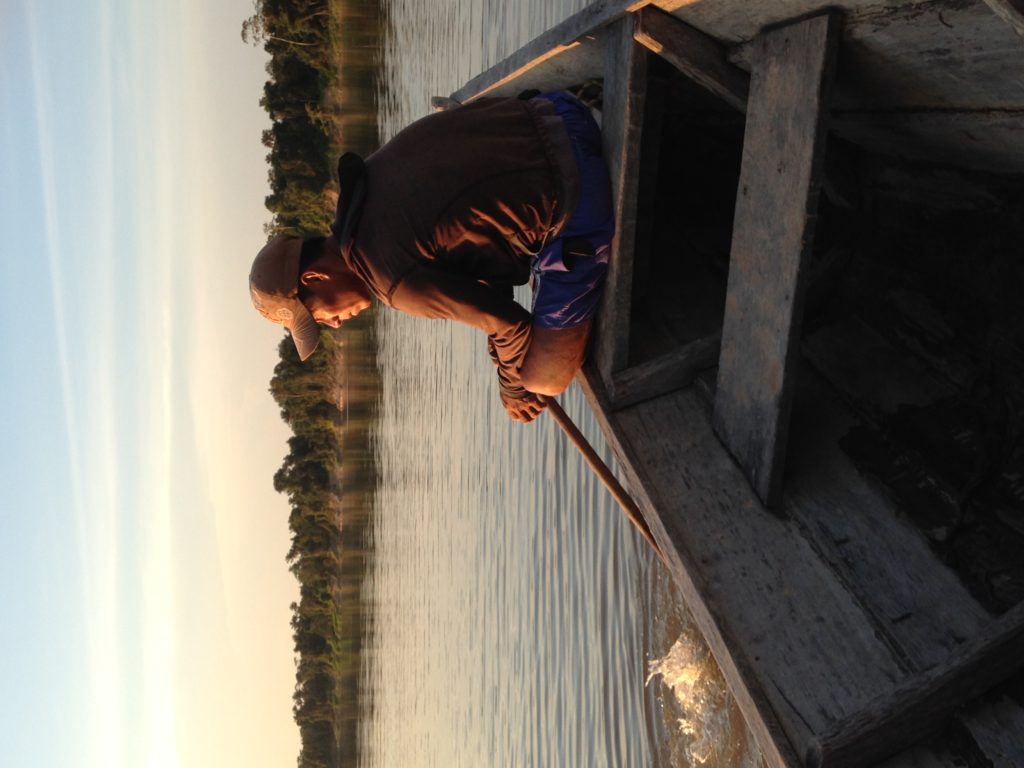
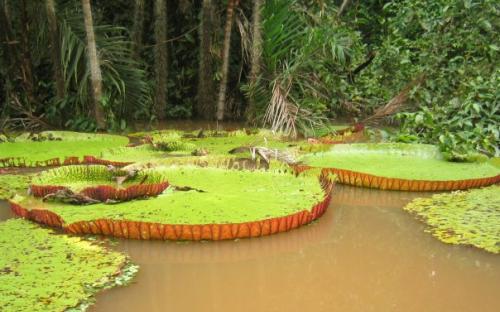


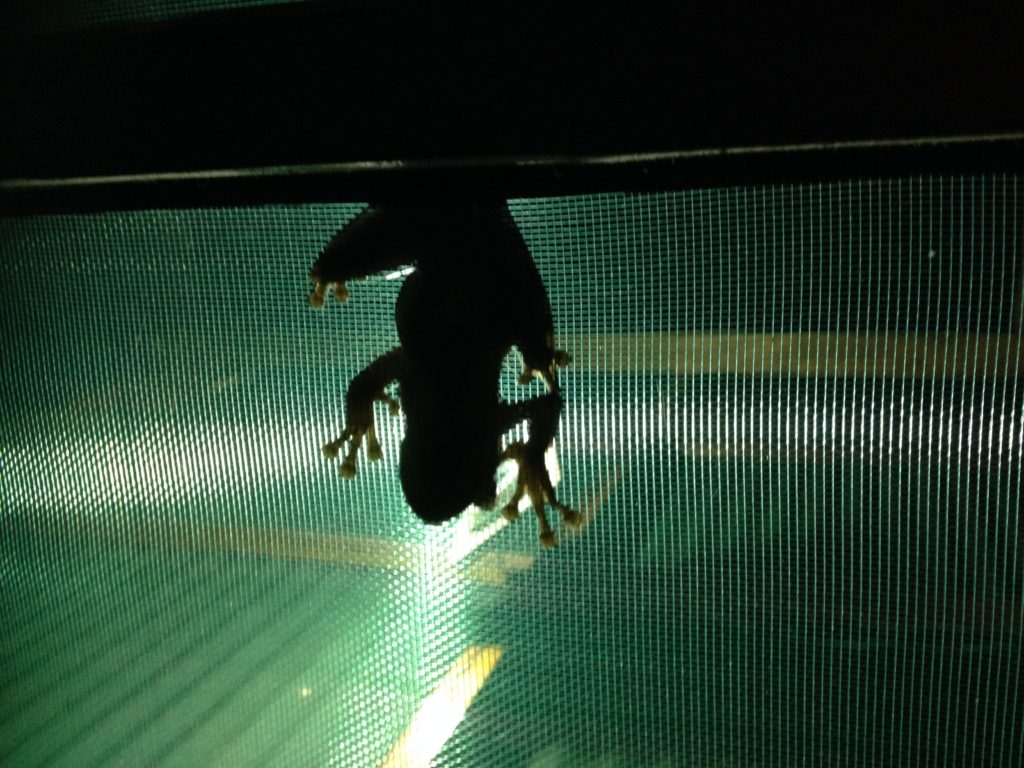
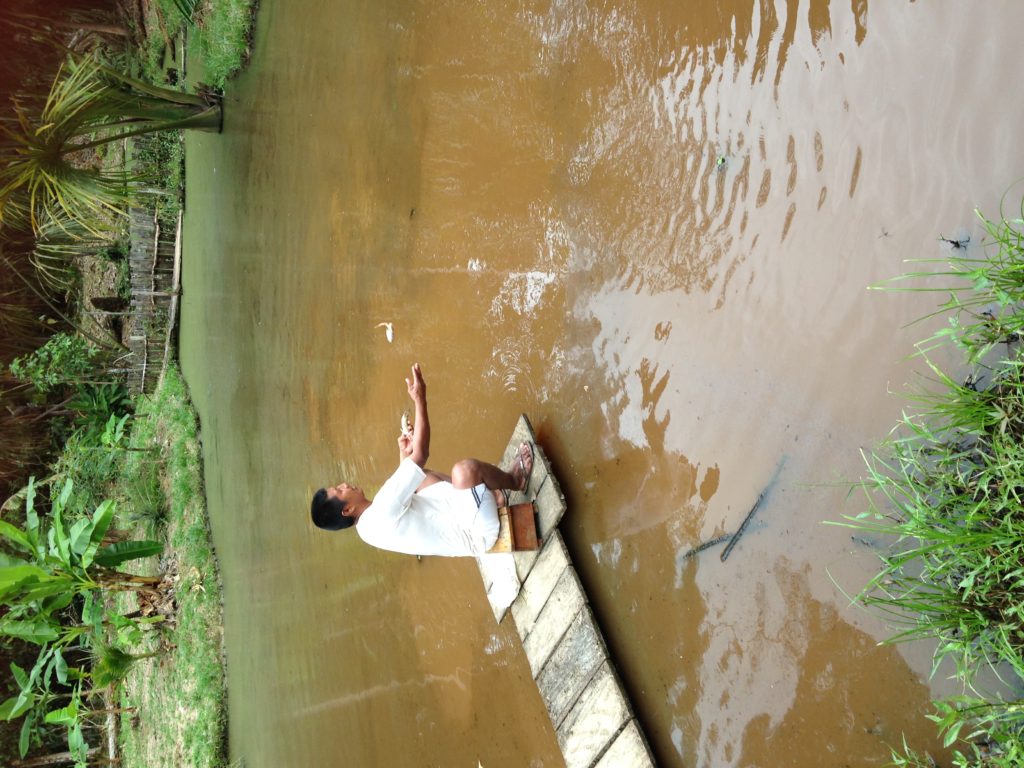
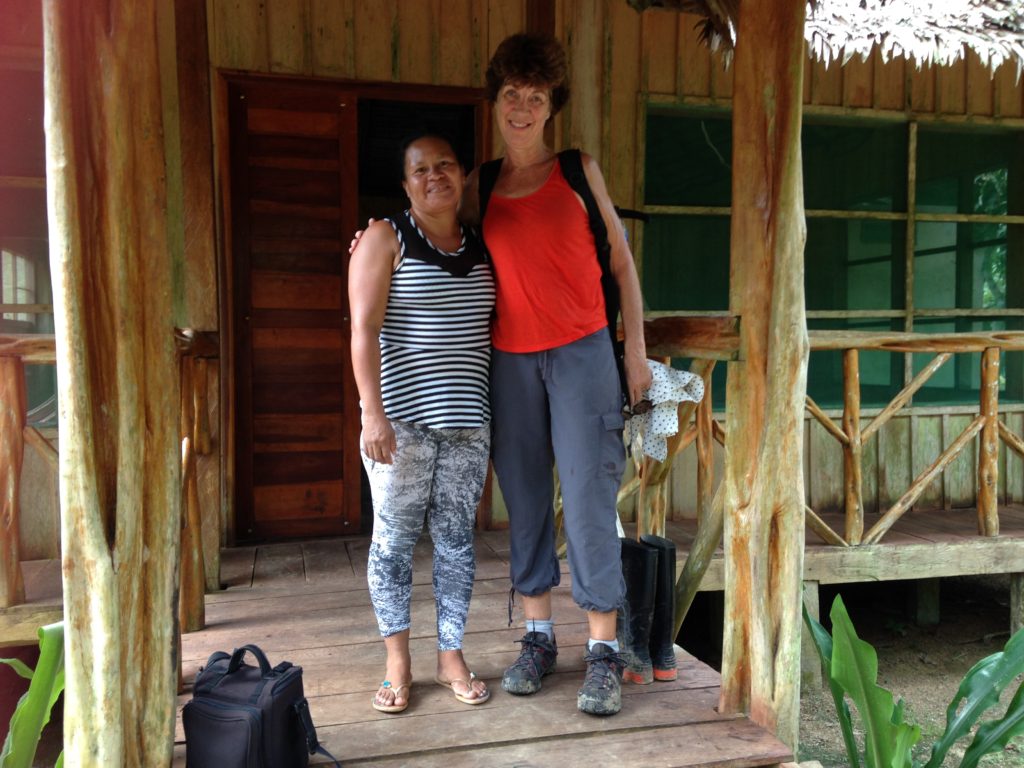
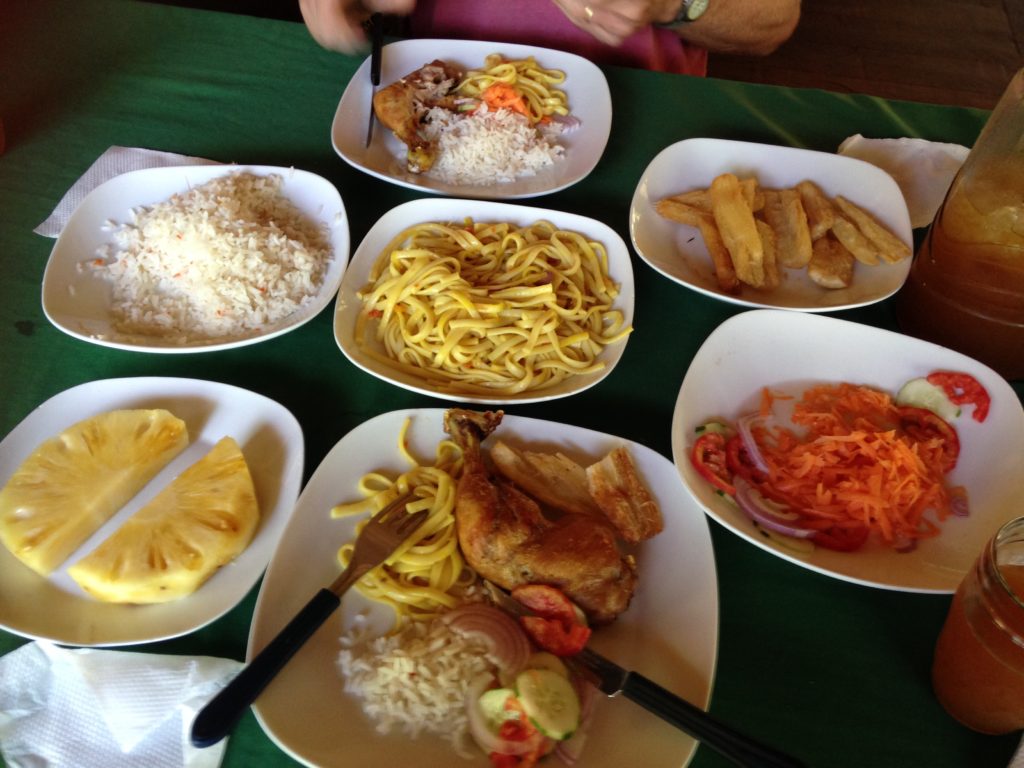

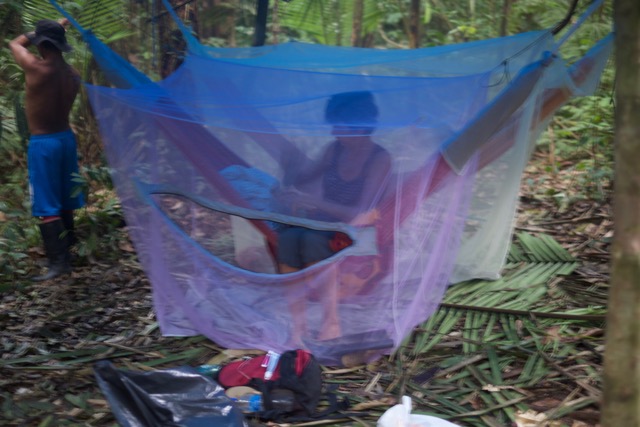







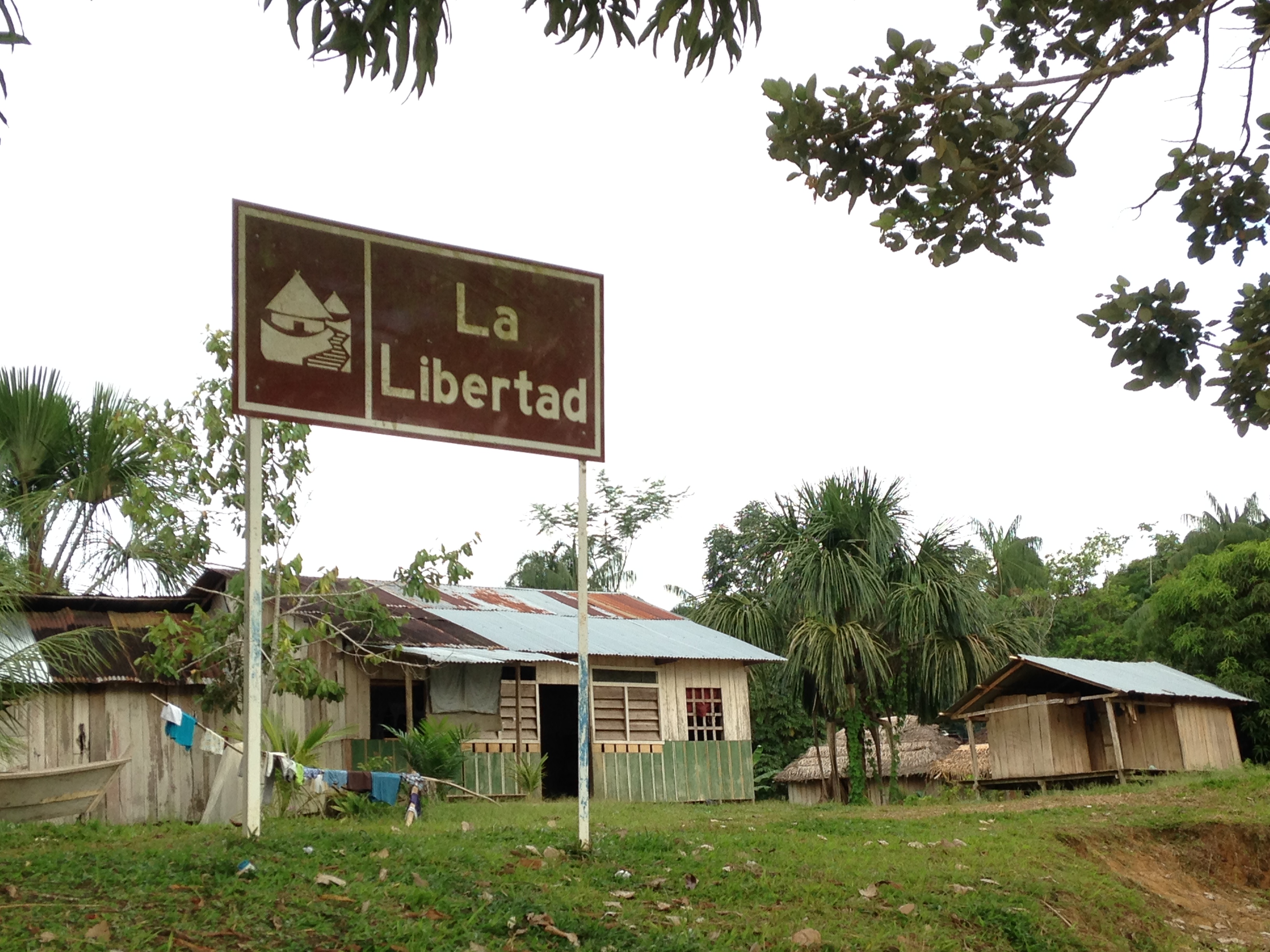
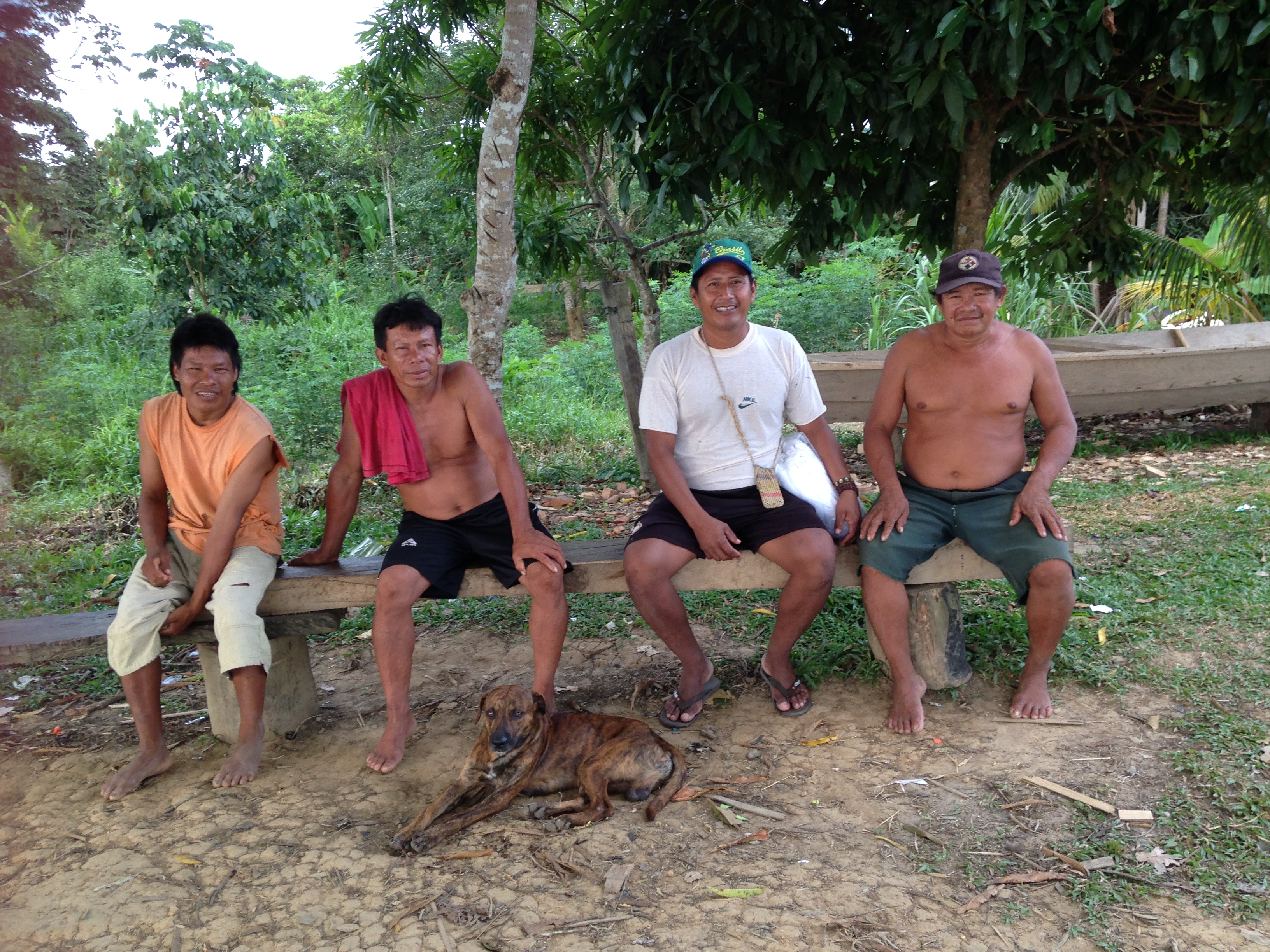
8 Comments
Karen Rochester
February 1, 2017 - 5:09 amLovely descriptions Annie. Such a shame about your camera, but what an adventure! xx
Judy
February 1, 2017 - 11:29 amThank you, Annie, for your colourful blog which has brightened my journey down to London on a grey drizzly day!
Liz Billington
February 1, 2017 - 11:46 amJust WOW – what a trip. Seems like another world to the one I inhabit! x
Ken Dolbear
February 1, 2017 - 12:27 pmWow! Your journey gets ever more amazing.
Ken
Annie
February 1, 2017 - 12:28 pmThanks all for your lovely comments. It was certainly an amazing time and wonderful memories xxx
The Jetski
February 1, 2017 - 12:48 pmWhat a fantastic adventure. Not too sure about that little spider on your hand though!
annie
February 2, 2017 - 1:38 amAhh, it was adorable! xx
Annie
February 1, 2017 - 8:58 pmNice to see the Foreign Office getting out and actually seeing something of the country. Didn’t happen much in my day.